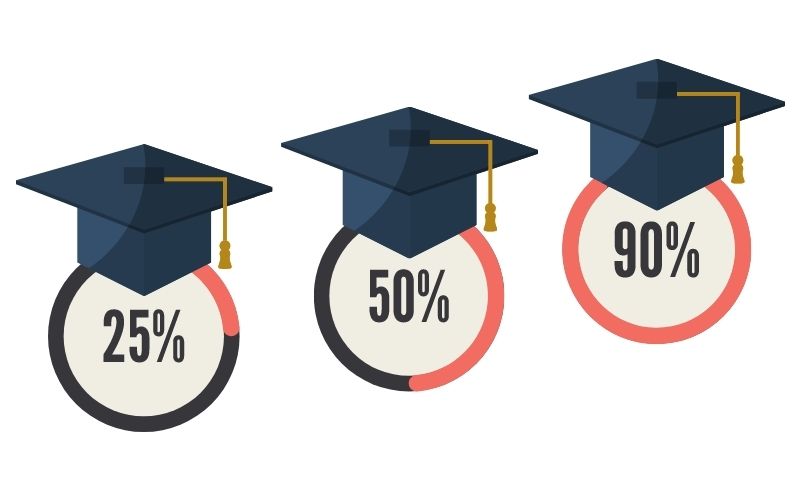I still remember sitting in the back row of a crowded auditorium during a graduation ceremony—watching friends walk the stage while silently thinking, I almost didn’t make it here.
I wasn’t failing out or anything, but life? It got in the way. Between part-time jobs, family stress, and not really knowing why I was even in school some days, finishing felt more like survival than success.
That’s why this topic matters so much. Graduation rates aren’t just statistics—they’re stories. Behind every percentage point is a student with a messy life, big dreams, and a whole lot of real-world weight on their shoulders.
What Do Graduation Rates Actually Measure?

Let’s break it down.
Graduation rates typically show the percentage of students who complete a degree or diploma within a certain time frame. For high school, it’s often four years. For college, it’s six.
But here’s the thing: those numbers don’t always tell the full story.
A student might take a fifth year and still be incredibly successful. Another might transfer schools, take a break for mental health, or pause to support their family. Are they counted? Sometimes yes, sometimes no.
Still, tracking graduation rates helps schools identify what’s working—and where support is falling short.
Barriers That Get in the Way of Graduation
If you’ve ever struggled to finish something big—college, a job program, even a long-term goal—you’ll get this.
Here’s what I’ve seen (and experienced) that can slow down or stop graduation in its tracks:
-
Financial stress – Tuition, books, housing—it adds up fast.
-
Lack of support – Academic or emotional. Especially for first-gen students.
-
Mental health challenges – Depression, burnout, anxiety… they’re real.
-
Work-life balance – Juggling jobs, school, and family isn’t easy.
-
No clear path – When you don’t see the purpose, it’s hard to stay motivated.
I’ve watched friends drop out not because they weren’t smart, but because they just couldn’t keep up with everything life threw at them. And honestly, I almost joined them more than once.
What Actually Helps Increase Graduation Rates
Here’s the good knowledge: there are real, practical ways to help students succeed. And they don’t always require huge budgets—just smarter systems and deeper support.
1. Early Intervention
Spotting students at risk (falling grades, absences, personal issues) and connecting them with help early can stop things from spiraling. It’s not about punishment—it’s about catching someone before they fall.
2. Academic Advising That Actually Advises
Too many students get generic guidance. What they need is someone who listens, helps them plan, and shows them a clear path from first year to finish line.
3. Mental Health Resources
Counseling, stress workshops, peer support groups—these are non-negotiable. Students can’t succeed if their brains and hearts are overloaded.
4. Flexible Learning Options
Online classes, night courses, part-time pathways—these options help students fit education into their lives, not the other way around.
5. Mentorship and Community
When students feel like they belong, they’re more likely to stay. Mentorship from faculty, alumni, or peers can be the difference between dropping out and pushing through.
The Role of Teachers, Parents, and Schools
It’s not just on students to finish strong. I’ve seen firsthand how the people around them make all the difference.
-
Teachers who check in beyond the grades.
-
Parents or guardians who encourage and listen—even if they’ve never been to college themselves.
-
Schools that create a culture of support, not just expectations.
I once had a professor pull me aside after class and ask, “You okay? You seem off this week.” That conversation reminded me I wasn’t invisible. It gave me the push to keep going.
Sometimes it only takes one person to help a student believe they can cross the finish line.
Why Graduation Rates Matter—But Aren’t Everything
Yes, higher graduation rates are good. They mean more students are completing their goals and getting access to better opportunities. But let’s not forget:
-
Some students take longer and still succeed.
-
Some find alternative paths that work better for them.
-
And some leave for reasons that aren’t about failure—but about choice.
We should absolutely track and improve graduation rates. But we should also look deeper—at student well-being, equity, purpose, and flexibility.
Because education shouldn’t be a race. It should be a path.
Love great food and unforgettable experiences? Check out Decology for the best in dining, recipes, and entertainment inspiration! – https://decology.com
Final Thoughts: It’s About More Than Just Getting the Diploma
Increasing graduation rates isn’t just a box for schools to check. It’s about helping real people finish something that can shape the rest of their lives.
I’m grateful I made it to graduation day. But I’m even more grateful for the people and resources that got me there.
If we want more students to succeed, we need to stop assuming they all start from the same place—and start meeting them where they are.
The Value of Extracurricular Activities: Enriching the Educational Journey
Extracurricular activities play a vital role in shaping well-rounded students, providing opportunities for growth beyond the classroom. [Extracurricular Activities: Enhancing Educational Experience] explores how these activities not only improve academic performance but also develop important life skills like teamwork, leadership, and time management. Whether you’re a student, parent, or educator, this article sheds light on the numerous benefits of extracurriculars and how they contribute to a more fulfilling educational experience. Check it out to learn more about why extracurricular activities are key to student success!

